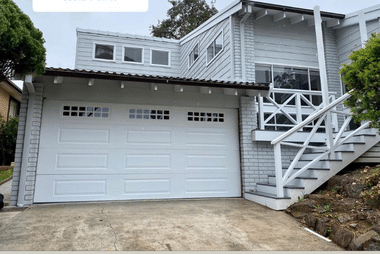Choosing a new garage door is a bigger decision than most homeowners realise. Beyond picking a style and colour, there’s one question that can significantly impact your comfort, energy bills, and wallet: Should you go with an insulated or non-insulated garage door?
The price difference between these two options can be substantial, leaving many people wondering if insulation is just a fancy add-on or a genuinely worthwhile investment. This guide will help you understand the key differences so you can make the right choice for your home.

What’s the Real Difference Between Insulated and Non-Insulated Garage Doors?
Let’s start with the basics. A non-insulated garage door is a single layer of material, typically steel or aluminium. It’s straightforward, functional, and gets the job done of opening and closing.
An insulated garage door has multiple layers. Most commonly, it features two layers of steel with insulation material sandwiched in the middle. This insulation is usually made from polystyrene or polyurethane foam, which helps regulate temperature and adds structural strength to the door.
The construction difference is simple, but the impact on your daily life can be significant, especially depending on your climate and how you use your garage space.

Energy Efficiency: How Much Can You Actually Save on Utility Bills?
This is where insulated garage doors really shine. If your garage shares walls with your home or sits directly below a bedroom, an uninsulated door can be a major source of heat loss in winter and heat gain in summer. That means your heating and cooling systems have to work harder, driving up your energy bills.
Insulated garage doors create a thermal barrier that keeps cold air out during winter and hot air out during summer. For homeowners in areas with extreme temperatures, this can translate to noticeable savings on monthly utility costs.
How much you’ll actually save depends on several factors: your local climate, how often you use your garage, whether it’s attached to your home, and your current energy costs. While you might not see dramatic changes if you live in a mild climate, homeowners in regions with harsh winters or scorching summers often see the investment pay for itself over time.
Durability and Noise Reduction: The Hidden Benefits of Insulation
Energy efficiency gets most of the attention, but insulated garage doors offer other advantages that many people don’t consider until after installation.
First, there’s durability. The extra layers in an insulated door make it sturdier and more resistant to dents and damage. If you have kids who play basketball in the driveway or you’re prone to the occasional parking mishap, that added strength can save you from costly repairs down the road.
Second, noise reduction is a game-changer for many households. Non-insulated doors can be surprisingly loud when opening and closing, with metal panels rattling and vibrating. Insulated doors operate much more quietly because the foam dampens sound and reduces vibration. If your garage is attached to your home or located near bedrooms, this quieter operation can make a real difference in your daily comfort.
The insulation also helps if you use your garage as a workspace, gym, or hobby area. It creates a more comfortable environment year-round, making the space actually usable rather than unbearably hot or cold.
Breaking Down the Cost: Initial Investment vs. Long-Term Value
Here’s the part that makes many homeowners hesitate: insulated garage doors typically cost more than non-insulated options. For a standard two-car garage door, that could mean an extra few hundred to over a thousand dollars upfront.
However, looking only at the sticker price misses the bigger picture. Insulated doors offer better return on investment in several ways. They can reduce energy bills, potentially for decades. They’re more durable, meaning fewer repairs and a longer lifespan. And when it comes time to sell your home, an insulated garage door can boost curb appeal and overall home value.
Garage door specialists often remind customers that the cheapest option isn’t always the most economical in the long run. It’s worth calculating the potential energy savings and factoring in the added durability before making a decision based solely on initial cost.
Which Type Is Right for Your Home? Key Factors to Consider
So, should you invest in an insulated garage door? Here are the key questions to ask yourself:
Is your garage attached to your home? If yes, insulation is almost always worth it to protect your home’s energy efficiency.
Do you use your garage for more than parking? If you have a workshop, home gym, or storage for temperature-sensitive items, insulation makes your garage far more functional.
What’s your climate like? Extreme heat or cold makes insulation a smart investment. Mild, temperate climates reduce the benefits.
What’s your budget? If money is tight, a non-insulated door might be the practical choice, but consider it a temporary solution if possible.

Ready to Upgrade Your Garage Door?
Choosing between insulated and non-insulated garage doors doesn’t have to be complicated. By considering your climate, how you use your garage, and your long-term goals, you can make a confident decision that fits your needs and budget.
If you’re still unsure which option is right for your home, Garage Doors Central Coast Pros can provide expert guidance tailored to your specific situation. Contact Garage Doors Central Coast Pros today for a free consultation and quote.